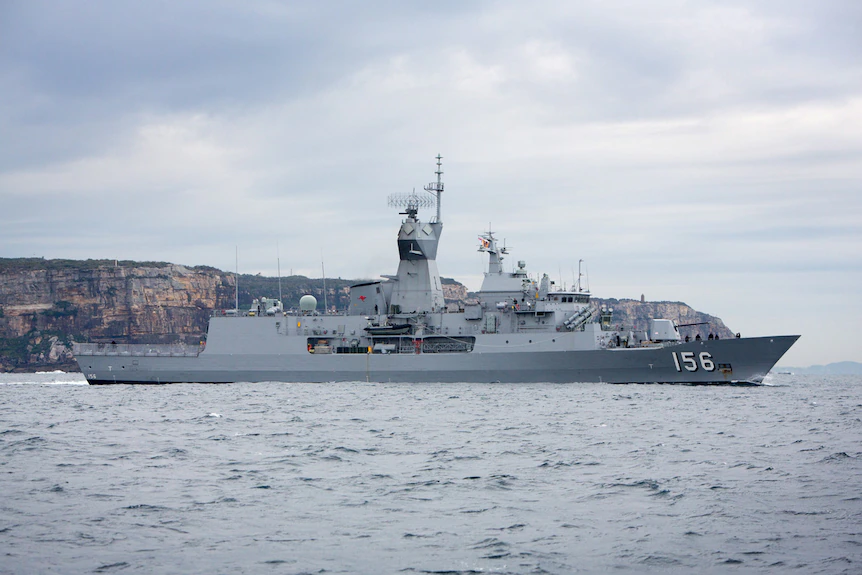
HMAS Toowoomba Naval Divers Forced to Leave Water Due to Sonar Pulses from Chinese Warship
ED: A sonar pulse, derived from the term “Sound Navigation And Ranging,” is a fundamental component of underwater acoustics used for various naval applications. Sonar technology encompasses two primary types: passive sonar and active sonar.
Passive sonar relies on specialized transducers known as hydrophones, which function as underwater microphones. Instead of emitting sound signals, passive sonar involves listening for acoustic signals generated by nearby ships. This approach allows vessels to detect and monitor potential threats without revealing their own location.
On the other hand, active sonar involves emitting controlled sound signals into the water. These signals travel through the water, reflect off underwater objects, and return as echoes to a receiver. Active sonar is further characterized by emitting short bursts or pings, rather than a continuous stream of sound. The returning echoes provide valuable information about the location and characteristics of submerged objects.
Naval platforms, including submarines and warships, leverage sonar technology for two primary purposes:
- Safe Navigation and Obstacle Avoidance: Sonar aids in navigating deep waters and avoiding obstacles. By emitting sound signals and analyzing the returning echoes, naval vessels can create a detailed picture of the underwater environment, identifying potential hazards and ensuring safe navigation.
- Anti-Submarine Warfare (ASW): Anti-submarine warfare sonar equipment is a crucial tool for naval platforms engaged in detecting, classifying, tracking, and countering underwater threats. This includes identifying submarines, torpedoes, and naval mines. Active sonar plays a significant role in ASW operations by actively seeking out and engaging potential threats beneath the water’s surface.
In the specific incident involving HMAS Toowoomba and the Chinese warship, the use of sonar pulses by the latter posed a risk to Australian naval divers who were conducting operations to clear fishing nets. The sonar pulses emitted by the Chinese warship not only raised safety concerns but also highlighted the significance of responsible and coordinated use of sonar technology in international waters.
Understanding the multifaceted applications of sonar technology is crucial for ensuring maritime safety, effective navigation, and the successful execution of anti-submarine warfare operations. The incident underscores the need for adherence to established protocols and international norms to prevent unsafe and unprofessional interactions in shared maritime spaces.
HMAS Toowoomba Naval Divers Forced to Leave Water Due to Sonar Pulses from Chinese Warship
Minor injuries have been reported among Australian naval personnel who were exposed to sonar pulses from a Chinese warship. The federal Opposition is urging the Prime Minister to clarify whether he raised the issue with President Xi Jinping.
The incident took place in international waters off Japan, where HMAS Toowoomba was supporting a United Nations mission to enforce sanctions. While the Australian frigate’s divers were engaged in clearing fishing nets from its propellers, the Chinese warship activated its hull-mounted sonar.
Defence Minister Richard Marles stated that the Australian frigate had issued multiple warnings about ongoing diving operations in the area. Despite acknowledging these communications, the Chinese vessel approached at a closer range. Subsequently, it was observed operating its hull-mounted sonar in a manner that posed a risk to the safety of the Australian divers, who were forced to exit the water. The divers sustained injuries to their ears, likely attributed to the sonar pulses.
Expressing serious concerns, the federal government has communicated the incident to the Chinese government. Minister Marles characterized the interaction as “unsafe and unprofessional.” He emphasized that Australian Defence Force (ADF) vessels have been conducting maritime surveillance activities in the region for decades, adhering to international law.
While the frigate was in international waters, it remained within Japan’s Exclusive Economic Zone, sailing towards Japan for a scheduled port visit. Shadow Defence Minister Andrew Hastie criticized the government for disclosing the incident after Prime Minister Anthony Albanese had left for the APEC summit in the US. Hastie called on the Prime Minister to explain the timing of the disclosure and whether he raised the matter directly with President Xi Jinping at APEC.
The incident occurred shortly after Prime Minister Albanese’s official visit to Beijing, described as a meeting of goodwill with President Xi Jinping. Only days later, President Xi met with US President Joe Biden in San Francisco, where both leaders pledged to resume military-to-military communications.
This incident follows heightened tensions between Australia and China last year when a Chinese surveillance ship operated off the West Australian coast near the secretive naval communications base at Exmouth.



